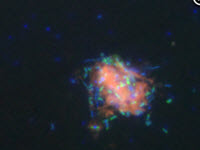
The Smithsonian’s Ocean Portal published an article that describes some of the discoveries that scientists have made about microbes in the Gulf of Mexico. Following Deepwater Horizon, researchers were armed with new genomic tools that enabled them to study marine microbes at sea, in their environment.
Funded by the Gulf of Mexico Research Initiative (GoMRI), these scientists discovered how diverse, specialized, and adaptive microbes can be. For example, some bacteria can thrive when crude oil is present and even seek it out. When they produce detergent-like substances into the oil, these bacteria can break it into small droplets, effectively serving as a natural oil dispersant.
You can read the Ocean Portal article titled A Bacterium’s Super Powers here: https://ocean.si.edu/conservation/gulf-oil-spill/bacteriums-super-powers.
Here are recent related stories:
- New Report! Deepwater Horizon Discoveries of How Microbes Mitigate Oil Spills
- Scientists Describe Breakthroughs in Genomic Techniques Since Deepwater Horizon
By Nilde Maggie Dannreuther. Contact maggied@ngi.msstate.edu with questions or comments.
************
GoMRI and the Smithsonian have a partnership to enhance oil spill science content on the Ocean Portal website.
The GoMRI is a 10-year independent research program established to study the effect, and the potential associated impact, of hydrocarbon releases on the environment and public health, as well as to develop improved spill mitigation, oil detection, characterization and remediation technologies. An independent and academic 20-member Research Board makes the funding and research direction decisions to ensure the intellectual quality, effectiveness and academic independence of the GoMRI research. All research data, findings and publications will be made publicly available. The program was established through a $500 million financial commitment from BP. For more information, visit https://gulfresearchinitiative.org/.
© Copyright 2010-2020 Gulf of Mexico Research Initiative (GoMRI) – All Rights Reserved. Redistribution is encouraged with acknowledgement to the Gulf of Mexico Research Initiative (GoMRI). Please credit images and/or videos as done in each article. Questions? Contact web-content editor Nilde “Maggie” Dannreuther, Northern Gulf Institute, Mississippi State University (maggied@ngi.msstate.edu).
